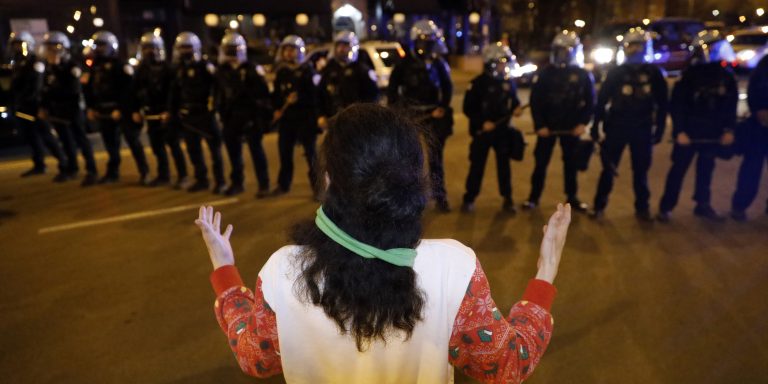INTELBRIEF
April 19, 2021
IntelBrief: A Crisis in American Policing

Bottom Line Up Front
- The ongoing murder trial of the former police officer accused of killing George Floyd now moves to closing arguments.
- Yet another killing of an unarmed black man – Daunte Wright – has brought more protests and outrage, as has the killing of 13-year-old Adam Toledo.
- The issue of police and judicial reform in America touches upon many uncomfortable truths, and both historical and current inequities.
- Ultimately, it is upon the police to reform to better serve their neighbors, not the other way around, and requires a sea change in training.
Last summer, the killing of George Floyd by police officers in Minneapolis, Minnesota promoted widespread protests and led to widespread calls for a systemic and comprehensive change in American policing – but many remain resistant to change. Progress has not been significant or swift enough; in the last month, a Black man, Daunte Wright, and a 13-year-old Mexican-American boy, Adam Toledo, were also killed by police, prompting further protests and underscoring the need for substantial change. The issue of policing in America is inextricably linked to both past and current issues of racism, classism, enforcement priorities, militarization, and a deep division between communities and their police departments. It is not communities that need changing, but police departments. Because these are painful issues that require deep uncomfortable conversations within communities, even families, they are difficult to sustain. Too often, the conversations flare but then quickly die down, at least until the next incident. And in the United States, there is always a next incident. Meanwhile, societal divisions are further exacerbated, and the very issues that need to be addressed remain unresolved – allowing this ongoing disproportionate risk to communities of color in the United States.
In Minneapolis, the trial of former police officer Derek Chauvin in regard to the death of George Floyd has now moved to closing arguments; his lawyers argued that the officer was within police policy and the law when he put his knee on the neck and back of George Floyd for over nine minutes, killing him. The former officer is charged with second-degree murder, third-degree murder, and second-degree manslaughter in the killing of George Floyd during an arrest that began over allegations of a counterfeit $20 bill. Alongside the trial last week, Daunte Wright was killed by a police officer during a traffic stop, only miles from the trial; the officer apparently mistakenly used her pistol when she meant to use her taser. This kind of mistake simply must not happen.
Holding individual officers and even entire departments accountable for their mistakes and crimes is an extremely controversial issue for the police. Law enforcement institutions frequently react to criticism – even constructive and supportive – with defensiveness. Understandably, the families of officers who put their lives on the line for communities may be reluctant to effect change that they deem could put law enforcement at great risk. Yet, it is also in the interest of officers’ own security to improve the relationship with the communities they serve. The disparate levels of severity and militancy in police responses to incidents – for example, the peaceful arrest of the shooter in Atlanta who killed eight people in March, relative to the several incidents described – demonstrate the capacity of police to de-escalate while performing their duties securely. Effective reform requires a sea change in training and in the reframing of the mission of law enforcement towards promoting security in a more holistic sense.
Reform will be challenging. Some departments and police unions argue that civilians are incapable of weighing in on the merits of police work. This shows a fundamental disconnect in how police view their profession and how their communities view and experience their results. Community oversight boards are met with hostility in some areas. Attempts to shift funding to areas that would reduce the number of 911 calls, specifically improved access to a range of social, mental, and health services, are often distorted as being “anti-police.” This happens even as police officers say most of the calls to which they are dispatched are not crime, but a result of other issues that could be addressed by more resources to the aforementioned services. The collective defensiveness increases the idea of “us versus them,” of police versus “civilians.” This mindset is toxic to community policing at all levels. It is this Thin Blue Line mentality that creates a dynamic in which there can be no dialogue or consensus because the job becomes viewed as a war, a war on crime with no room for discussion or nuance.
There are common-sense, easy-to-implement steps that can help reduce tensions and increase safety for all involved. Violent crime requires police action, both in the immediate response and then in a transparent investigation that focuses on accountability for the offenders. Yet, there are many areas now assumed to be police matters that can be addressed differently. For example, while motor vehicle regulations are important, enforcement of minor issues such as registration decals can be done through other means than traffic stops, which have often escalated. Heavy enforcement for regulation violations that lead to fines further compounds the issue. The fines can lead to suspensions that lead to warrants, many of which disproportionately impact communities that can little afford to address them; this risks creating a negative cycle of interactions with law enforcement for limited gain. At its core, American policing should be focused on enabling and empowering all neighbors to build better lives and communities and providing a secure space for them to do so. This requires deliberate and thoughtful crime reduction and prevention measures, in which the community must have a meaningful role and voice. While this might be uncomfortable to departments unaccustomed to this level of scrutiny and partnership, it is a crucial part of the larger change and reform needed in American policing today.